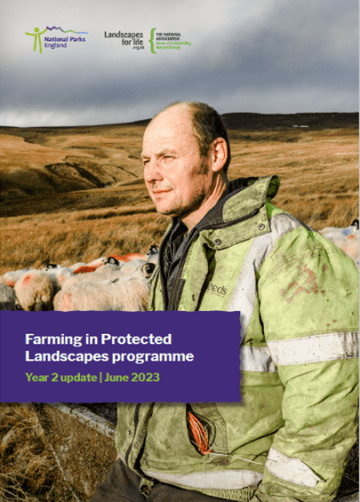New report celebrates Farming in Protected Landscapes
More than 5,000 farmers and land managers have now benefited from the Farming in Protected Landscapes (FiPL) programme, new figures have shown.
The programme, now in its third year, offers funding to farmers across AONBs and National Parks. Support for nature recovery and climate resilient businesses, heritage conservation and better access for people to enjoy our protected landscapes all feature in programme delivery. To date, £25 million has been allocated, and more than 2,400 projects have been approved for funding.
The new report – Farming in Protected Landscapes programme: Year 2 update – showcases projects across National Parks and Areas of Outstanding Natural Beauty (AONBs) which have benefited from the Defra funding. Examples include The Pollinator Project in North Wessex Downs AONB – a group of 20 farmers collaborating to improve the landscape for key pollinators and invertebrates; and Dalefoot Farm in the Yorkshire Dales, an area which includes SSSI designation, supporting nature recovery through the establishment of a network of hedgerows, riparian strips and trees that connect the existing ancient semi-natural woodland.
Neil Heseltine, NPE Chair and Chair of the Yorkshire Dales National Park Authority, said: “Our work across protected landscapes to help farmers and land owners engage with the FiPL programme shows how important partnership working and collaboration are to driving forward sustainable land management initiatives. As a farmer myself, I have seen the nature and biodiversity crisis that the country faces grows more acute. Whilst farming is often seen as one source of this crisis, it is only through harnessing farmers as partners in aspiration, that we will overcome it. The challenge is to inspire and reward farmers for delivering positive benefits for nature whilst running profitable businesses. It is therefore essential that the Government commit to embedding the principles of FiPL within the environmental land management offer beyond 2024.”
Tom Munro, Dorset AONB Manager and NAAONB Agriculture & Land Use Panel spokesperson added: “The huge successes of FIPL over the last two years has demonstrated how AONB teams are uniquely placed to facilitate on-farm projects to deliver for nature, climate, people and place across these treasured landscapes. While our pre-existing networks with farmers and advisers helped us hit the ground running, FIPL has helped us cement these relationships and to be regarded as trusted delivery bodies. These landscapes have been shaped by thousands of years of farming and it’s only by working like this at scale with farmers that we will adequately respond to the climate and ecological emergency while ensuring rural communities thrive underpinned by sustainable farm businesses.”
The report was launched today (20th June) at a meeting of the All Party Parliamentary Group (APPG) for National Parks. Attendees heard from representatives from across protected landscapes and farming community about the importance of sustainability and land management to the future of these special places, and how farmers and other land managers play a vital role in shaping the landscapes they operate within to enhance the natural and cultural heritage, improve productivity, and create more vibrant, sustainable communities.
Key cumulative figures from the FiPL programme since it began:
More than 2,400 projects have been approved for funding so far
- The number of farmers engaged in the programme has exceeded 5,000
- Programme funding for farmers and land managers to date is more than £25 million
- The programme has created 42 new farm clusters and helped support 106 existing ones
- Funding has supported 485 Projects to reduce flood risk
- The number of volunteers engaged through the programme is over 5,000
- Over 100 miles (approximately 190 km) of new hedgerow have been planted
- 8 miles (approximately 13 km) of dry-stone walling have been restored
The full report, Farming in Protected Landscapes: Year 2 Update, can be found here
Farming in Protected Landscapes (FiPL): FiPL is a funding programme from Defra which funds projects in protected Landscapes which reflect at least one of the four themes: nature, climate, people and place. It is for one-off projects and is now in its third year.
Environmental Land Management scheme (ELMs): ELMs is part of the Government’s Agricultural Transition plan. Defra are expanding their schemes to pay farmers and land managers to provide environmental goods and services alongside food production; and are providing one-off grants to support farm productivity, innovation, research and development.
There are 46 Areas of Outstanding Natural Beauty Areas of Outstanding Natural Beauty (AONBs) across England (34), Wales (4) and Northern Ireland (8). They are protected by the nation for everyone. They are places where landform, climate, species, industry, heritage, culture and language come together to create something unique and distinctive, shaped by generations and waves of people. Some of the nation’s most iconic views are in AONBs: from the tin mines of Cornwall AONB to the silhouette of Bamburgh Castle in Northumberland Coast AONB, Willy Lott’s farm in Dedham Vale AONB (the subject of Constable’s Haywain) to the stark uplands of North Pennines AONB. AONBs are the nation’s nearby countryside – 66% of England’s population lives within a half hour journey time of their nearest AONB. AONB’s are the nation’s landscapes.
The National Association for Areas of Outstanding Natural Beauty is a charity that provides a strong collective voice for the UK’s AONB Network. Its objectives are to promote the conservation and enhancement of AONBs, advance the education, understanding and appreciation by the public of AONBs.
Web: www.landscapesforlife.org.uk
Twitter: @naaonb @AONBFamily
National Parks England (NPE) brings together English National Park Authorities to provide a strong, collective and expert voice at a national level. We shape policy by drawing on our extensive experience, facilitating discussion, sharing knowledge, cultivating partnerships, and testing innovative solutions to some of the biggest challenges facing society.
For more information about the report, contact:
National Parks England (NPE):
National Association for Areas of Outstanding Natural Beauty (NAAONB):


